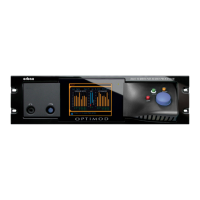3-6
OPERATION ORBAN MODEL 8685
We have supplied several presets tuned for the Microsoft WMA (V9) at 32 kbps in
stereo. This codec has severe artifacts at this bitrate and no preprocessing can mask
them completely. The 8685’s WMA presets strictly limit the amount of high fre-
quency energy applied to the codec. To prevent the processing from adding L–R en-
ergy, these presets operate with full stereo coupling and without stereo enhance-
ment.
The 8685’s ability to maintain source-to-source spectral consistency is also an impor-
tant advantage. Once you have set up the processing to minimize codec artifacts
caused by a given piece of program material, the 8685 will automatically minimize
codec artifacts with any program material.
Speech/Music Detector
The Speech/Music Detector allows the 8685 2.0 processing to change its processing
parameters depending on whether the input program material is speech or other
material (usually music).
The algorithm is straightforward: Speech is detected if (1) the input is mono and (2)
there are syllabic pauses at least once every 1.5 seconds. In the 2.0 channel processor,
speech with a stereo music background will usually be detected as “music,” or the
detector may switch back and forth randomly if the stereo content is very close to
the stereo/mono detector’s threshold. Mono music with a “speech-like” envelope
may be incorrectly detected as “speech.” Music incorrectly detected as “speech” may
exhibit a slight loss of loudness and punch, but misdetection will never cause objec-
tionable distortion on music.
Speech that is not located in the center of the stereo sound field will always be de-
tected as “music” because the detector always identifies stereo material as “music.”
The 8685’s surround processing handles speech differently. It does not use an auto-
matic speech/music detector, instead assuming that speech is mainly located in the
center channel. The center channel compressor in each frequency band can be tuned
differently than the compressors for the remaining channels, which are coupled to
preserve imaging. Main-to-center channel coupling controls allow you to set the
maximum permitted gain difference between the center channel and the remaining
channels. This allows the processing to automatically maintain an appropriate bal-
ance between dialog and non-dialog parts of the audio.
Sound-for-Picture Applications: Controlling Dynamic Range
The most crucial commandment in sound for picture is this: dialog must always be
intelligible (although in contemporary mixes this commandment seems to be broken
with surprising regularity). Sound for picture is usually heard under less-than-ideal
conditions and its dynamic range must be controlled accordingly. Apartment-
dwellers must set their volume controls to avoid disturbing neighbors or even other
members of the family. At the quiet side, intelligibility of dialog is often impacted
by environmental noise like children playing or a dishwasher going in the kitchen.
When one considers that the hearing acuity of a significant portion of the audience
is somewhat impaired compared to that of a healthy 20-year-old, one concludes that

